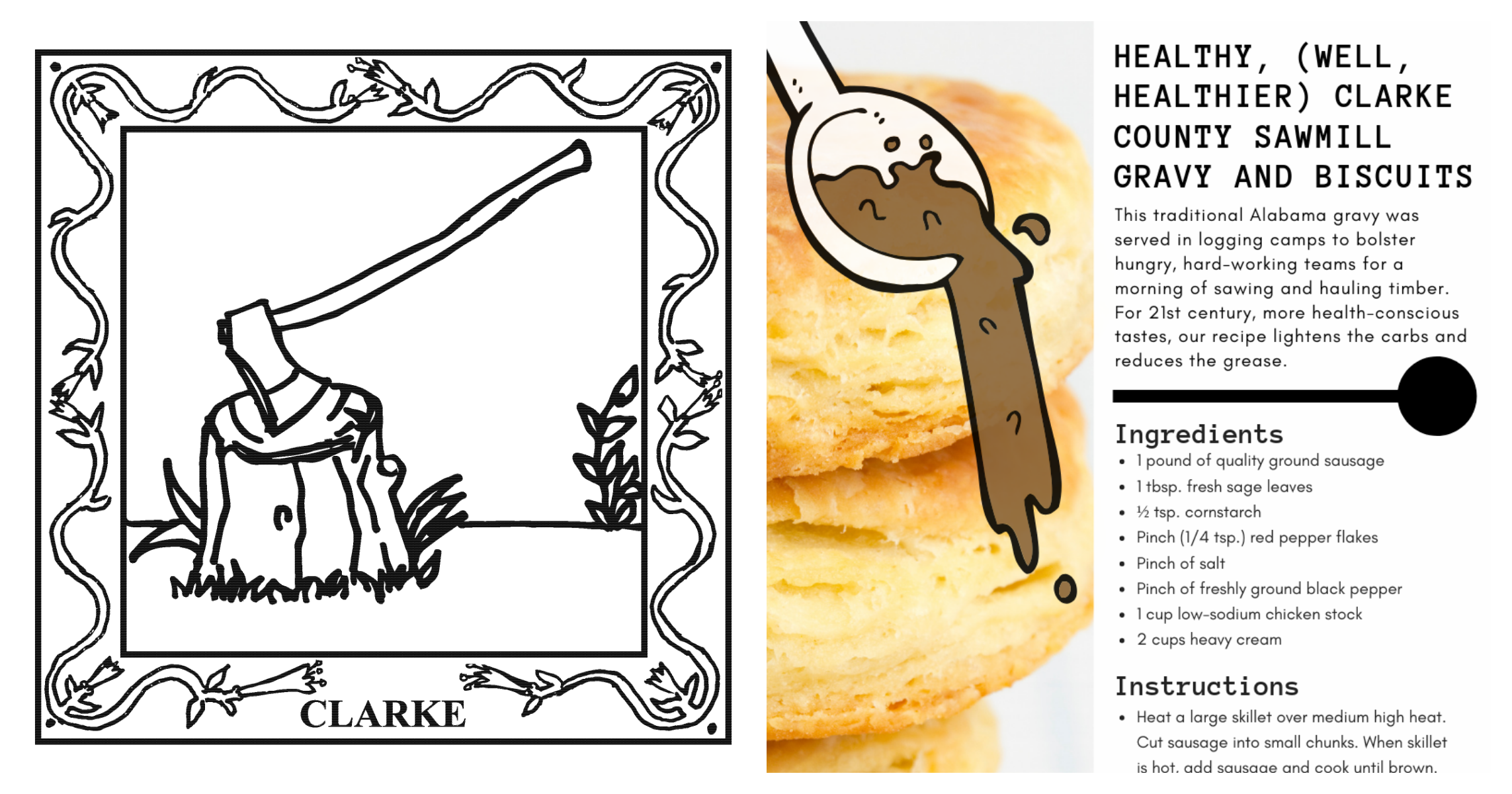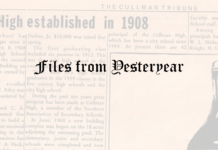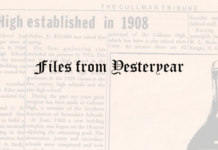The Alabama honeysuckle border was inspired by an 18th century, Southern applique quilt.
The Cullman Tribune is celebrating the Alabama Bicentennial (1819-2019) with statewide field reporting by Alabama Master Gardener/Botanical Artist Ben Johnson South. This year-long feature, "The 67-County Alabama Garden Party," will spotlight different counties each week. Each county will get its own "quilt block," along with a historical profile, and we'll share a recipe specific to the area. At the end of the year, all 67 counties will be put in a book to commemorate the Bicentennial.
Clarke County
If you want to hit the reset button and reconnect with your real self, immerse in real, natural beauty, Clarke County, Alabama, about an hour’s drive north from metropolitan Mobile, is a real, good destination. Clarke County is “authentic Alabama” deep in timber country. True to any long-established place, there is sophistication here, but even the more cultured folks are comfortable with keeping the local vibe real and regularly a bit rough-hewn.
Clarke County was admitted to the Alabama Territory by the Legislature in 1812, seven years before statehood. The dense forests and twisting, two-lane roads have helped this part of Alabama remain mostly rural, and the relative remoteness resists the mind-numbing blur and blandness of freeway travel, city living and suburban sameness. When you’re in the middle of 21st century Clarke County, even in the picturesque towns and crossroads, it’s easy to imagine an Alabama of 200 years ago, vital with farming and logging.
What I most intensely recall from my visits to Clarke County are the fragrances like cedar and pine which connect PLANTS + PEOPLE even more than the green, green pastures and wooded landscapes. You can close your eyes and be transported back in time. The pines in this part of Alabama are more likely to be long leaf, loblolly or slash, but like fancypants wine judges who sniff corks, you could blindfold some locals and simply by smell they could discern whether a tree is white pine or red pine, and some can even identify the type of soil the plant grew in and in what part of the county.
The logging camps only ended during my lifetime. Until the 1960s, hard-working Clarke County loggers would leave their families before dawn on Monday morning and return around dusk the following Friday. During the work week, they harvested the bountiful trees by sawing or using a mule, by skidding. (“Alexa, what is tree skidding?”) Some of the trees were processed on-site, but today, almost all are hauled by truck from the stump to a sawmill or lumber yard. In early times, giant trees were taken to the banks of the Tombigbee River and rafted to Mobile for processing. Clarke County lumber is still treasured today, hardwoods for furniture-making and high-grade flooring and softwood conifers like pine for structural building.
“TIMBER!” is a cry that has been heard thousands of times through the 200-plus years of Clarke County history. It’s a warning alert to fellow workers that a tree is being felled. Logging is not for the faint of heart; people in this naturally treacherous part of Alabama have learned how to take care of themselves and look after their neighbors. These are folks you’d like to run the river with.
Clarke County has a rich legacy of storytellers and fabulists, a posh term for fable-makers that should you use it in these parts could get you a funny look where even world-class, prize-winning authors are celebrated simply as real good tall tale spinners. The storytelling gift evolved from long stretches without outside entertainment or news. Folks here are primed for a good story and have a log truck full to return the pleasure.
One of the Alabama’s, indeed America’s, finest fabulistas was Thomasville’s Kathryn Tucker Windham. Miz Kathryn, as many of us fondly remember her, was best known for her “haint” tales compiled in the bestseller, “13 Alabama Ghosts and Jeffrey.” When the author was laid to rest in an Alabama pine box the summer of 2011, a photograph she took of Jeffrey, her household ghost, was placed next to the casket. One of many beloved Alabama storytellers, Donald Davis, spoke at her memorial and shared that when Miz Kathryn asked him to deliver the eulogy he demurred, “I told her I might cry if I get up there.” Like a typical, no nonsense Clarke Countian, Mrs. Windham told him, “Have you ever seen a ghost?” Then, she paused and with classic, comic timing, she shook a finger at him and added, “Well, honey if you cry, you’re gonna see mine.”
While writing this piece on Clarke County, I chatted with Kathryn Tucker Windham’s close friend, Linda Vice, a longtime Alabama tourism agent and KTW’s Thomasville neighbor. Ms. Vice reminded me there are many fun and “possibly, even part-true” tales by Kathryn Tucker Windham about PLANTS + PEOPLE. A favorite for Ms. Vice is Windham’s “Christmas Narcissus” inspired by the mischievous, young, Windham children, Ben and Dilcy, digging up all the early-blooming narcissi in a neighbor’s yard to surprise their mother on Christmas Day.
Kathryn Tucker Windham’s tales are a colorful bouquet of Alabama folklore, Clarke County memories and homegrown recipes. Her cherished part of the state comes bountifully alive on the pages in “The Grapevine Swing,” “Cornbread” and “Aunt Bet’s Trees.” Go add the books to your home library and also hear her unabashed, south Alabama drawl saved for the ages on YouTube.
Here are some other pleasurable examples of how PLANTS + PEOPLE come together in Clarke County, including a, gird yourself this is not an oxymoron like “jumbo shrimp,” real recipe for HEALTHY, SAWMILL GRAVY:
- THE BEST PLACE IN CLARKE COUNTY TO TAKE A LANDSCAPE PHOTOGRAPHER/ARTIST—The local, Alabama Cooperative Extension System Coordinator, Kevan Tucker, an ardent ambassador for PLANTS + PEOPLE agritourism in this part of Alabama, immediately recommended a vantage point at Silver Creek Park on the Alabama River with a “breathtaking vista of the river, rolling hills, lowland plants and forests as far as the eye can see.”
- PLANT-RELATED BUSINESS—Clarke County has some good-sized employers that are regularly hiring in forest and lumber jobs; Scotch Plywood, Boise Paper, Alabama Pole and Pile, Thomasville Lumber, Cantor Lumber, Gulf Lumber, Louisiana Pacific
- CLARKE COUNTY GARDENING STAR—If you’re a plant tourist adventuring in this part of Alabama, the “go to” home garden legend I kept hearing about is John Hall; apparently, he understands the soil and climate from years of trial-and-error-and-trial-again experience and he’s successfully grown and cooked just about everything under the sun. Contact this generous-spirited, fellow plant enthusiast through the Alabama Cooperative Extension System or just ask anybody you see in this friendly, everybody-knows-everybody part of the state.
- CLARKE COUNTY CULINARY ORIGINS—This is down-home, Alabama farm cooking, but sauces are a bit more refined possibly because this area was once a trading post between the native Creek and Choctaw tribes with early French settlers. Clarke County was known for salt production during the American Civil War, and cooks here seem to have an innate understanding of flavoring.
- PLANTS LURE DEER, FOX, QUAIL and RABBITS—Plan for hours to hike and explore the 5,500 protected acres of the Fred T. Stimpson Special Opportunity Area (SOA).
- GAINESVILLE METHODIST CHURCH and CEMETERY—Historic, wooden sanctuary built in 1819, celebrating their own Bicentennial with Alabama this year
- FORT SINQUEFIELD— This wooden stockade built to protect white settlers from indigenous people, was attacked in Sept. 1813 by Red Stick warriors, and 12 women and children were killed and scalped; other confrontations resonate with PLANTS + PEOPLE encounters: a skirmish in canoes between Red Sticks and Sam Dale’s militia men, a dramatic conflict at the Battle of Burnt Corn.
- GAINESVILLE ONE-ROOM SCHOOLHOUSE—Wooden structure built in 1913 and expanded to two rooms in 1930, now on the National Register of Historic Places
- PLANTING AN IDEA—How about creating an ALABAMA GHOST GARDEN in Thomasville near the Kathryn Tucker Windham Museum? This could be something like the Scottish legend of “Brigadoon,” which mysteriously appears and disappears year-to-year on a certain day. It could be a chalk or stone outline of one of many homestead gardens in Clarke County that have become lost in time over the past 200 years. However it might be conjured, please invite us avid plant tourists. And, pretty please with Clarke County sugarcane syrup on it, there must be magical, local storytellers.
Many thanks to Kevan Tucker, Alabama Cooperative Extension System. The website is http://offices.aces.edu/Clarke. For up-to-date info on events and workshops check their Facebook page at Clarke County-Alabama Extension. And, a giant, “thank you” bouquet of Christmas narcissi to Thomasville treasure, Linda Vice, for sharing her memories of Kathryn Tucker Windham.
HEALTHY, (WELL, HEALTHIER) CLARKE COUNTY SAWMILL GRAVY and BISCUITS
This traditional Alabama gravy was served in logging camps to bolster hungry, hard-working teams for a morning of sawing and hauling timber. For 21st century, more health-conscious tastes, our recipe lightens the carbs and reduces the grease.
INGREDIENTS
1 pound of quality ground sausage
1 tbsp. fresh sage leaves
½ tsp. cornstarch
Pinch (1/4 tsp.) red pepper flakes
Pinch of salt
Pinch of freshly ground black pepper
1 cup low-sodium chicken stock
2 cups heavy cream
INSTRUCTIONS
Heat a large skillet over medium high heat. Cut sausage into small chunks. When skillet is hot, add sausage and cook until brown. Drain off excess grease. Put skillet with the sausage over lot heat. Stir in sage, cornstarch and red pepper flakes. Gradually stir in the chicken stock as you continue stirring. Increase heat to medium and bring mixture to a simmer. Keep stirring until mixture thickens to a roux-like consistency. Stir in the heavy cream. Bring mixture to a simmer. Turn heat to low and keep stirring. Stir in salt and black pepper and remove from heat. Pour over warm, low-carb biscuits.
Serves 8.
Also, check out Alabama Bicentennial: 200 ways to save Alabama for the next 200 years.
Copyright 2019 Humble Roots, LLC. All Rights Reserved.























